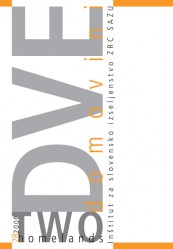Internet as a medium in the maintenance of the National and Cultural heritage among Slovenians around the world. The old dilemmas of the new solutions.
Keywords:
Internet, Virtual ethnic groups, Slovenian emigrants, National and Cultural heritage, communicationAbstract
The authors use different theories and fieldwork findings to discuss communication and national and cultural heritage of Slovenians abroad in the cyberspace. The fast expanding technology produces numerous changes that significantly influence its users. Recently, the relatively static, one-way communication of the »classic« web pages has been replaced by the interactive forums, pages with uploaded videos, blogs and updated web pages. This makes it more difficult to find criteria for evaluation of the material and define what can be identified as the national and cultural heritage. The material is therefore the entire debate itself, a communication between certain groups of individuals who are discussing values, myths, stereotypes, cultural practices and identities, and subsequently transfer their virtual meetings into the physical world.
Downloads
References
Ang, Ien (1991). Desperately seeking the audience. London; New York: Routledge.
Anderson, Benedict (1998). Zamišljene skupnosti: o izvoru in širjenju nacionalizma. Ljubljana: SH.
Appadurai, Arjun (1990). Disjuncture and difference in the global cultural economy, v: Global culture: nationalism, globalisation, modernity (ur. M. Featherstone). London: Sage.
Appadurai, Arjun (2001). Globalization. Durham, NC; London: Duke University Press.
Bauman, Zigmund (2002). Tekoča moderna. Ljubljana: Založba /cf*.
Bhaba, Homi (1994). The Location of Culture. London, New York: Routledge.
Boden, Deirdre in Molotch, Harvey L. (1994).The compulsion of proximity, v: NowHere Space, Time and Modernity (ur. R. Friedland in D. Boden). London, UK: University of California Press.
Castells, Manuel (2001). The Internet galaxy: reflections on the Internet, business, and society. New York; Oxford: Oxford University Press.
Casey, Edward S. (1998). Giving a face to place in the present, v: The fate of place, Berkeley, California: University of California Press.
Cikić, Sanja (2002). Povezovanje Slovencev po svetu s pomočjo Interneta: Vzpostavljanje virtualnih etničnih skupnosti. Dve Domovini/Two Homelands, 16: 81–98.
Čavič, Uroš (2008) Nekaj zelo kratkih misli o Facebooku in Myspaceu, http://www.dsolutions.si/about_si.htm (5. 9. 2008).
Dufoix, Stephane (2008). Diasporas. Berkeley, California: University of California Press.
Elkins, David J. (1997). Globalization, telecommunication and virtual ethnic communities. International Political Science Review, 18, 2: 139–152.
Elkins, David J. (1999). Think locally, act globally: reflections on virtual neighbourhoods. Javnost/The Public, 6, 1: 37–54.
Fraser, Nancy (2005). Transnationalizing the public sphere. http://www.republicart.net/ disc/publicum/fraser01_en.pdf, (1. 4. 2008).
Galloway, Aleksander R. (2004) Protocol. Cambridge Massachusetts: The MIT Press.
Giddens, Anthony (1990). The consequences of modernity. Stanford, Calif.: Stanford University Press.
Giddens, Anthony (1991). Modernity and Self–Identity: Self and Society in the Late Modern Age. Stanford, California: Stanford University Press.
Hall, Stuart (1993) Cultural Identity and Diaspora. Colonial Discourse & Postcolonial Theory: A Reader. (ur. Williams, Patrick & Laura Chrisman). New York: Harvester Whaeatsheaf, 222–237.
Hall, Stuart (1997). Introduction. Representation: Cultural Representations and Signifying Practices (ur. Stuart Hall). London, Thousand Oaks, New Delhi: Sage, 1–13.
Hannerz, Ulf (1996). Transnational connections: culture, people, places. New York: Routledge.
Hannerz, Ulf (2003). Being there… and there… and there!: reflections on multi–site ethnography. Ethnography, 4, 2, 201–216.
Lefebvre, Henri (1991). The production of space. Oxford, UK; Cambridge, Mass., USA: Blackwell.
Laguerre, Michel (2002). Virual Diasporas: A New Frontier of National Security, http:// www.nautilus.org/gps/virtual-diasporas/paper/Laguerre.html (20. 8. 2008).
Meden, Ahac (2007). Spletne strani Slovencev po svetu. Dve Domovini/Two Homelands, no. 26: 47–73.
Mitchell, William J. (1995). City of bits: space, place, and the Infobahn. Cambridge, Mass.: MIT Press.
Mikola, Maša (2005). Živeti med kulturami. Ljubljana: Založba ZRC SAZU, Zbirka Migracije.
Miller, Daniel in Slater, Don (2000). The Internet: an etnographic approach. Oxford, New York: Berg.
Mlekuž, Jernej (2008). Burek.si?! Ljubljana: Studia Humanitatis, Zbirka Varia.
Noelle Ignacio, Emily (2005) Building Diaspora. New Brunswick, New Jersey, London: Rutgers University Press.
Okence v Slovenijo, http://www.datamarkets.com.ar/Okenceslo/ (31. 8. 2008).
Rheingold, Howard (1994). The virtual community: homesteading on the electronic frontier. New York, NY: HarperPerennial.
Shohat, Ella (1999). By the Bitrstream of Babylon: Cyberfrontiers and Diasporic Vistas. Home, Exile, Homeland: Film, Media, and the Politics of place (ur. Hamid Nacify). New York, London: Rutlege, 233–237.
Thezaurus: Slovenian language and cultural resources, http://www.thezaurus.com, (1. 4. 2008).
Triglav-Stuttgard, http://www.triglav-stuttgart.si/forum/, (3. 8. 2008).
Triglav-return, http://www.youtube.com/watch? v=CdKeuF4T8WM (1. 9. 2008).
You Know, http://www.facebook.com/group.php?gid=2225152464 (2. 9. 2008).
Urry, John (2000). Sociology beyond societies: mobilities for the twenty-first century. London: Routledge.
WELL, Whole World 'Lectronic Link. http://www.well.com/ (4. 2008).
Žitnik Serafin, Janja (2008). Statistical facts are human fates: unequal citizens in Slovenia. Journal of ethnic and migration studies, 34, 1: 77–94.
Downloads
Published
How to Cite
Issue
Section
License

This work is licensed under a Creative Commons Attribution-NonCommercial-NoDerivatives 4.0 International License.
Authors guarantee that the work is their own original creation and does not infringe any statutory or common-law copyright or any proprietary right of any third party. In case of claims by third parties, authors commit their self to defend the interests of the publisher, and shall cover any potential costs.
More in: Submission chapter





